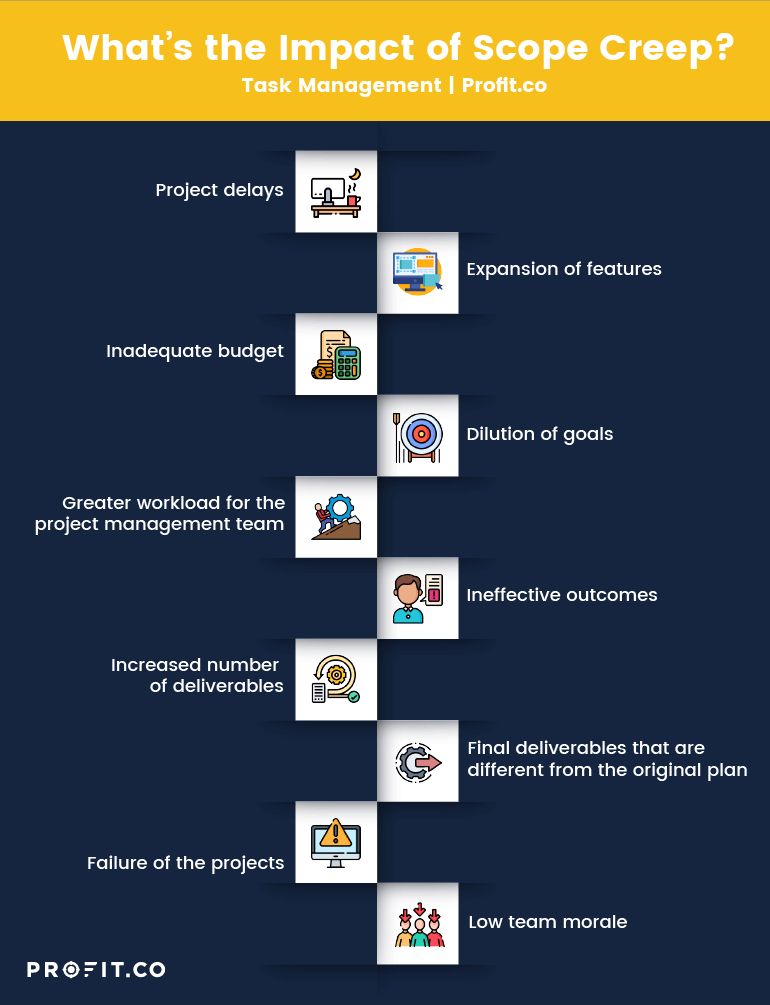Successful organizations are always clear about what their top priorities are and have clearly defined goals, tasks, activities and outcomes. When they start a project, they take all these into account in project planning. This is called the scope of the project. However, everything may not necessarily go according to plan every time.
Plans are of little importance, but planning is essential.
What is scope creep?

Small changes are sometimes made in the project during implementation. This causes minor deviations from the original scope of the project. When more and more small changes are gradually added, they can accumulate slowly and snowball into a bigger impact on the project. This is called the scope creep.
Impact of scope creep

Scope creep may lead to:
- Project delays
- Expansion of features
- Inadequate budget
- Dilution of goals
- Greater workload for the project management team
- Ineffective outcomes
- Increased number of deliverables
- Final deliverables that are different from the original plan
- Failure of the project
- Low team morale
While the ramifications of scope creep are of varying degrees of importance, managers and leaders should be aware of all the potential outcomes of letting a project get too far away from its initial plan.
Are you looking for a software that can help you transparently manage the goals, tasks, and employees within your organization? Look no further than Profit.co! Try out Profit.co completely free for 30 days!
What causes scope creep?
Many things can cause scope creep. Take a look at the following reasons:
- There could be changes in external conditions that might necessitate altering the project.
- The client requirements may change half way through the implementation of the project.
- When the clients do not communicate their vision properly, it may lead to scope creep.
- Lack of coordination between the client and the project management team can alter the course of the project.
- Having multiple contact points in the team and/or in the client side can result in getting multiple views from various deciding authorities mixed up, leading to changes made without a consensus from all stakeholders.
- A change in the leadership team at the client side may lead to a change in their vision halfway through the project implementation.
- There could be a lack of good understanding of the original project and its scope, leading to the misinterpretation by the managers.
- Sometimes, the organization may have unhealthy competition within itself, which may lead to different teams or managers trying to take the project in different directions.
- Teams may add extra features that the clients did not ask for, to make a good impression.
- When the management promises more than what they can deliver, it could cause scope creep and place unnecessary stress on the team.
These conditions may force unforeseen and unplanned adjustments to the project and make you diverge from the original plan to add additional features as the project evolves. As a result, the original goals may change, altering the scope of the project, and resulting in scope creep.
Scope creep example
Scope creep can happen in any project. For instance, if you are designing an e-commerce website for a retail business, you may have noted all the requirements given by the stakeholders during the planning process. You would have discussed with them to finalize the budget, draw out the deliverables and fix a deadline. After that, you may have converted the plan into an action plan and shared the responsibilities with different teams in your organization.
Suppose your initial plans were to keep a conventional contact form for customers to write to your client’s retail business. If a trend of incorporating artificial intelligence and chat bots into customer service to provide automated replies to customer’s queries emerges in the market, the client would most likely ask you to add that to the feature list. The likelihood of this happening is much higher if the competitors of the client have already incorporated that feature in their site.
Halfway through the project implementation, if the client places a request to add such an automated chat bot, it will be a major undertaking. Your team will be forced to change their priorities to focus on this new feature. They will spend a considerable amount of time and additional resources in integrating such a feature. It would affect the original plan, overshoot the budget and potentially cause delays.
After some time, if the marketing team of the client finds that a different product search algorithm can be more effective in achieving conversion, you may again be forced to incorporate that change. If changes like these keep adding to your work, it can result in scope creep. Trying to do too much in a short time with limited resources is a recipe for failure.
Why is scope creep important?
The thin line between flexibility and failure
It is impossible to completely avoid or eliminate scope creep from your projects. Projects are mostly dynamic in nature, and changes during strategy execution are inevitable. While scope creep can create problems, forcibly eliminating it by not accepting any change can also harm the project.
So, there’s always a thin line between being flexible enough to accept changes in the project and allowing the changes to accumulate and cause project failure. Walking this fine line and managing scope creep can offer some benefits.
A well-managed scope creep can help you by:
- Keeping your project relevant, despite changing market conditions
- Keeping your team sharp and adaptable
- Ensuring customer satisfaction and retention
- Improving profitability
- Preparing you for the future challenges
Market conditions are constantly changing, especially in these uncertain times. Keeping up with the changes and adapting to market conditions can keep the project relevant and help you deliver the best possible finished product.
Scope creep can help your team remain operationally sharp, as they constantly accommodate changes and use the best practices in project management and task management to keep the project on track. They become better at adapting to changes and completing their deliverables despite the changes.
Being flexible and accommodating changes requested by the clients during the implementation of the project creates a good impression. Proactively managing scope creep and making the project successful by accommodating all the changes requested by the clients helps you retain clients, find new clients, and maintain a high customer satisfaction score.
Accommodating more changes through the course of the project enables you to charge more for the additional deliverables. This will increase your revenue and result in higher profitability.
Scope creep is characteristic of constant changes and unforeseen challenges. Managing it and constantly learning from constraints and setbacks helps your team develop the ability to weather similar challenges in the future and manage scope creep better in upcoming projects. It will also help you optimize your processes as well as your task management and project management skills and tools.
10 tips to manage scope creep
Sometimes, scope creep is unavoidable. Successful organizations are able to set themselves apart because they’re prepared for the unavoidable hiccups in their planning and project management process. Below, we list out some of the ways that you can manage scope creep and avoid project failure:
- Anticipate changes and be proactive
- Involve all stakeholders in planning and achieve consensus
- Document the project requirements and clearly define the scope of the project
- Finalize the expectations out of the project and sign a contract
- Discuss with your team and clarify everything
- Improve your task management practices
- Put in place effective change management and risk management processes
- Use the right tools for project management
- Be flexible, but only to a certain extent
- Give clients the choice to add more deliverables at additional cost
Accept the fact that every single project can potentially undergo modifications during implementation and anticipate changes proactively. Create a plan with regard to how you will manage the additional tasks, add extra features, and complete the extra deliverables at the end of the project, in case the client comes up with changes.
Discuss the scope of the original project with clients frequently, reminding them of what is possible so that even if they come up with changes, it will not drastically alter the scope of the project and you can properly manage expectations. Create a backup plan in case the changes affect the implementation of the original plan.
When the client doesn’t understand the scope of a project, it can cause scope creep. So, as a first step for every project, it is critical to talk to the client and understand their requirements. After making sure that the client and you are in agreement over the requirements, you can start the planning process.
If there is a conflict between the expectations of one stakeholder and another, you have to manage the conflict first, so that it won’t affect the project at a later stage. It is essential to build consensus over the plan and arrive at an agreement or the scope and deliverables. Changes made during this planning process are much easier to manage compared to the ones made during the project implementation. So, any final changes to the project should be requested in the planning phase itself to avoid extensive scope creep.
It is extremely important to document the project requirements. It clarifies the scope of the project and puts into writing what you have agreed upon with the client and other stakeholders. The document may record all the requirements, project details, goals, deliverables, duties and responsibilities, timelines, milestones and mechanisms to track the progress of the project. This record can be shared on a common platform so that anyone who wants to revisit the details of the project can instantly access it.
While documentation creates a formal record of the scope of a project, a written contract places an obligation for everyone to keep changes and deviations from the original plan within certain limits. This step goes a long way in preventing anyone from making extensive changes that may lead to uncontrolled scope creep.
Once the project planning is over and all the details are documented and finalized, the next most important step is to discuss the scope of the project, priorities, goals, duties and responsibilities of different teams and individuals with your teams so that there will be clarity amongst the employees at all levels.
You have to clearly communicate the project requirements. Misunderstanding the scope, poor communication amongst teams and lack of coordination and cooperation can cause scope creep. So, it is crucial to align the workforce towards the common goals and make teams work together towards their respective outcomes and the overall deliverables of the project. Clarifying everything right before the commencement of the project helps to avoid scope creep.
A project is not a single task that can be completed by an individual. Project implementation involves careful division and allocation of tasks and activities to different teams and individuals. It is crucial to create a list of tasks and prioritize them in the right order while allocating them to various teams and individuals. This task management and prioritization process should reach every level of the workforce. Only then will your team be aligned towards what is important and be able to focus on priorities, even when unforeseen changes occur in the project and its scope. You can also create a timeline and prepare a schedule that can be shared with everyone so that everyone can adhere to their deadlines.
Changes are inevitable; however, the impact of the changes in the project can be minimized and managed if you have a flexible change management process that helps to control the changes. Changes cause scope creep mainly when they are accepted without a formal review. A formal change management process eliminates this oversight and makes sure if the changes are acceptable to everyone. It also ensures that the timelines, budget, and deliverables are adjusted according to the new changes. You can discuss change management with the client so that changes to the project or not made without proper review of the implications.
Sometimes, the gaps in project management can also lead to poor performance and inability to accept changes to the project. So, it is vital to use the right project management tools and boost the performance of the teams to avoid scope creep.
To learn more about Profit.co’s business management tools that enable more focus, alignment, and achievement in your organization, book a free demo with our experts.
While a flexible approach certainly allows changes to be added, you do not have to accept and approve every change requested by the stakeholders. It is crucial to evaluate the potential impact of the changes on the entire project and decide whether it is worth implementing the changes. A wrong decision or a miscalculated move in implementing changes can have serious consequences on the project. So, at times you have to reject the changes that may cause unchecked scope creep.
Saying no to a client can be difficult. So, instead of totally rejecting a sweeping change, you can provide the stakeholders with a choice as to whether they want to shelve the change or go ahead despite the additional cost, extra payment for the work, and an extended deadline. This helps to maintain a smooth relationship with the clients while keeping scope creep in check.

